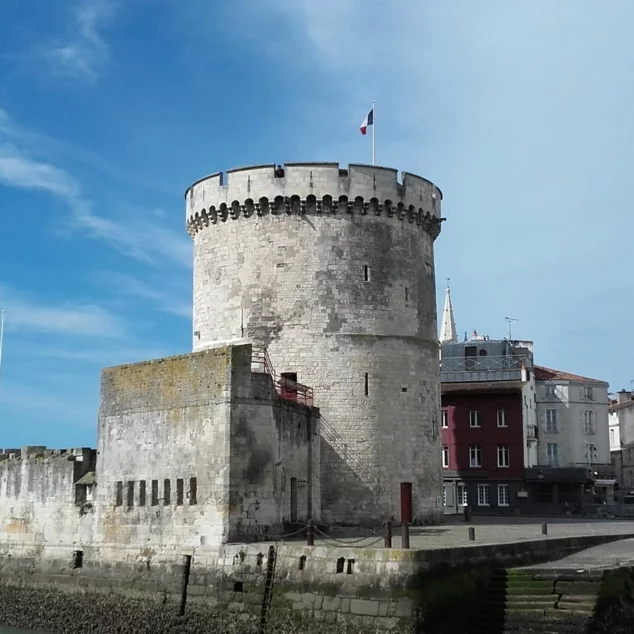A must-see
article | Reading time5 min
A must-see
article | Reading time5 min
In 1985, the French artist Jean-Pierre Pincemin (1944-2005) and the Swiss artist Gottfried Honegger (1917-2016) were commissioned by the French government to create contemporary works of art that can still be seen today in the Lanterne Tower.
The work by Jean-Pierre Pincemin (1944-2005) in the Lanterne Tower occupies the entire floor space of the Jehan Mérichon room on the fifth level. It is made of white and black coloured concrete over an area of 84 m2, and was begun in 1985 and completed in 1986.
The work was commissioned by the French government at the time of Culture Minister Jack Lang.
The artist designed a random, rhythmic repetition of a black-and-white circular arc module - a motif already used in his canvases as early as 1968, and which would be used again for subsequent commissions (for the floors of the César Franck house and the VIP lounge at the Charléty stadium in 1994, and for the ceiling of the small municipal theatre in Villeneuse sur Yonne in 2000).
In the mid-1980s, the artist briefly described his project in a preparatory document :
Born in Paris in 1944 and died in Arcueil in 2005, Jean-Pierre Pincemin was a painter, engraver and sculptor. Throughout his life, the self-taught artist alternated between different creative media: canvases, collages, prints, monumental works, sculptures, etc., constantly moving back and forth between the figurative and the abstract, dream and reality, colour and monochrome, the intimate and the gigantic, etc.
With the Supports / Surfaces group in the 1960s, he questioned the role of the artist and the status of painting. He also explored colour and the organisation of the coloured surface.
In the 1980s, Jean-Pierre Pincemin drew inspiration from traditional Indian, Japanese and religious motifs, as well as fables from the Middle Ages. He nourishes his work by drawing on the most diverse cultures and periods, without freezing his work in a single style or medium. He integrated and interpreted these multiple influences to create an eminently personal body of work.
In the years that followed, and until his death in 2005, Jean-Pierre Pincemin never stopped exploring new avenues, in the form of huge canvases, monumental public commissions, small paintings on earthenware and a great many prints.
Restoration work on the Lanterne Tower (2013-2016) provided an opportunity to renovate Gottfried Honegger's Untitled.
This work was created in 1985 as part of a public commission by the French government, led by Culture Minister Jack Lang.
As well as the column of chromed aluminium cones, it originally included a labyrinth made of granite blocks placed in the centre of the tower, on a wooden floor.
In a text describing his approach, Gottfried Honegger says: "The Lantern Tower has a rich past. At once a lighthouse, a defensive element and a prison, the tower reflects, through the traces it still bears, the suffering of those who were imprisoned there. This state of affairs has determined my work, and I hope that I have been able to bring the public and the building closer together through the eloquent language of art, in its silence. I chose the top floor because of the tower itself, which is experienced from within. All my efforts have been directed towards drawing the public's gaze upwards, towards the incredible beauty of this architecture. The aim of my steles is to draw the public's gaze upwards, towards the incredible beauty of this architecture, a movement that I accompany and support with lighting effects and the appropriate musical accompaniment.
The artist was dissatisfied with the work and asked for it to be redesigned. The renovation of his work in 2015 provided the opportunity. As well as restoring the chrome plating on the cones, he modified the central device by placing a round mirror on a red square base.
In addition, the soundtrack created in 1986 had disappeared. Following a collaboration established with the Institut de recherche et de coordination acoustique/musique (IRCAM) with the support of collectors Jean Philippe and Françoise Billarant, a new musical environment was created based ona work by Pierre Boulez and Claude Debussy .
The installation combines simple, uncluttered elements and forms with a combination of materials (wood, metal, mirror). The articulation of the whole (floor, table, suspended column) gives a sensation of both lightness and vertigo . The space seems to be multiplied by the reflection of the vault in the mirror. And when visitors lean over the mirror, it is as if they are plunged into the void.
The five panels of stained glass in the skylight, designed by the artist and also restored, offer visitors a play of light and colour reminiscent of churches and cathedrals.



